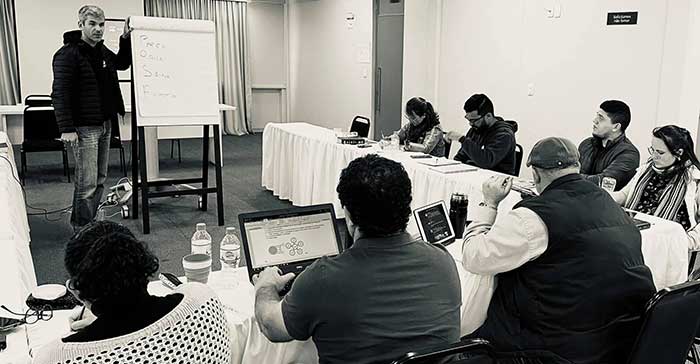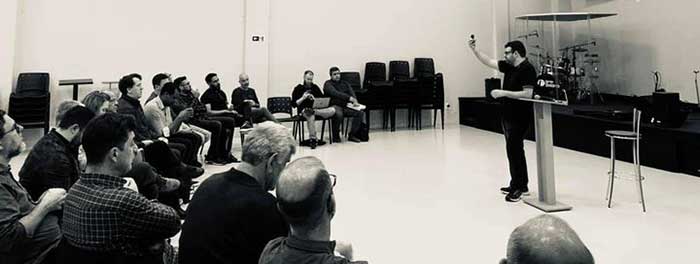No longer letting life lead in Brazil
Ben Greene
Pastor & writer
- Missions
Bruno Serafim da Luz began as a Roman Catholic in Criciúma, a city in southern Brazil. Later, spiritism – a hybrid of French and Brazilian religious teachings – captured his heart in college. After that, having a big house and nice cars, as well as impressing women, steered his life.
Yet, there came the point for Serafim da Luz when deixa a vida me levar was no longer the best way to live.
At 32 years old, Serafim da Luz was a gym owner and physical therapist. That’s when a patient invited him to worship at a church. A few months later, he went on a retreat with that church, and everything changed.
Related: The power of an invitation
“I met with God, I had an encounter with God,” he said of the 2013 moment. “I knew that everything was changing in my life.”
“Something happened in my heart,” he told his parents after coming back. “I don’t want more girls or money. I want to follow Jesus.”
Southern Brazil has quietly become a least-reached area
Southern Brazil is semi-tropical. Most of the city centers are near the coast, and many have European heritage.
For example, the four or five homestyle restaurants in New Venice import their flour from Italy to make their pasta. An authentic Venetian gondola eases through the small town’s waterways.
There’s also a Hungarian town designed around the coffee shops, pastries and restaurants of Hungarian history.
Missionaries have been in southern Brazil for 100 years. There are churches scattered around the region. But there are very few in proportion to the millions of people.
“The situation here is very bad in southern Brazil. We don’t have many good churches,” Serafim da Luz explained.
Moreover, Serafim da Luz realized there were very few churches in the city center. Few were making disciples.
Related: Disciple making where the past and future collide
So, with good reason, Serafim da Luz continued going to the church that led to his salvation. But, over time, he realized bringing friends to that church wasn’t easy.
That’s why he started talking with his pastor about opening a new church with that pastor’s help.
“I knew that God was calling to me to start a new church, a different church with good theology, with a different practice ― to preach the real gospel, the gospel of grace. To call the people to repentance and to be like Jesus,” he said.
In the end, that pastor stayed put but sent Serafim da Luz out with a blessing for the new ministry.
Still, Serafim da Luz had nowhere to turn for resources or training on starting a church. Growing up Roman Catholic, blending in spiritism and being a businessman didn’t prepare him.
The solid doctrine and ministry skills he was learning as a student at Martin Bucer Seminary were beneficial. But he needed something more.
All his friends and family, plus business connections and acquaintances, live in Criciúma with him. But they couldn’t help him answer an essential question: How do I start a church?
Related: Models of church planting (podcast)
Starting a church begins with partners
“I knew that I needed help from other churches, and I knew that I needed to know other pastors and other organizations,” he said.
The answer, part of it anyway, was coming from Sao Paolo, 1000 miles north of Criciúma, where God was redirecting the ministry of Jonathan and Erin Mathews.
Jonathan Mathews grew up a missionary kid in Sao Paolo. He returned to the city as an adult. After several years in Sao Paolo, the Mathews family was prayerfully considering how to follow God and stay in Brazil.

Before 2015, he was a church planter making disciples who multiplied their faith and ministry.
“I realized that wasn’t sustainable,” Mathews said. “I had to raise up leaders who could multiply themselves in others.”
In 2015, the Mathews shifted their ministry focus. They stopped planting churches to train and support indigenous church planters. In his first attempt at the new focus, Jonathan partnered with a church planter pastor for three years.
Related: Every leader needs a coach
“We walked alongside a leader and helped catalyze in them a kingdom vision for their community,” he said.
When that partnership created a successful ministry, Mathews felt encouraged to take this new calling seriously.
“I was yearning for more because I’d seen it work for one guy,” he added.
With a new desire comes a new direction
In 2017, while continuing to help that church planter, Mathews met Converge leaders from Converge International Ministries.
A gospel movement among the unreached peoples of southern Brazil, Argentina and Uruguay existed on paper. However, the Southern Cone Initiative needed a leader.
Mathews’ experience in a supporting role motivated him to continue this new approach to ministry. In early 2020, the Mathews and their five children were moving south to Criciúma.
“We thought we had a game plan for what the Southern Cone Initiative would look like,” Mathews said. “The disruption of the pandemic basically canceled everything we prepared. We had to step back and say, even though our plans are canceled, ‘God, what would you have us do?’”
Related: Missionaries see God working during coronavirus crisis
What was a shutdown for Mathews was, in fact, a chance to serve Serafim da Luz. He had started Aviva Church in the downtown core of his city. But he was still eager for mentoring and relationships.
Within six months of arriving in southern Brazil, the Mathews realized their service to God during the pandemic would focus on Aviva Church.
How could leaders from different cultures partner?
“Many people came to Christ. Many people were baptized,” Mathews said. “The church doubled in size in the first year. God has placed us here for just such a time as this.
“I had a dream, but I didn’t have much help or knowledge to reach those dreams,” Serafim da Luz said. “We’ve built good strategies, so the church was growing in the middle of the pandemic. We saw God is working here.”
He, Mathews and others planned and prepared, built a solid mission statement, a biblical vision statement and good values.
Related: Getting your church excited about your vision (video)
“These are generating movement that many people are wanting to receive Jesus or be restored to Jesus, in the middle of a pandemic,” Serafim da Luz said.
Converge helps Aviva Church find a new worship space
A key example of Aviva Church’s meaning to the community comes through the downtown location. Most churches in the city centers around southern Brazil are in the city suburbs.
Because of European influence, these cities of more than a million people have city centers that are the hub of the community’s life. And, Serafim da Luz said, there was no church in the center of Criciúma.
Finding an affordable location in the city center is difficult. But the pandemic lowered prices. And, Serafim da Luz explained, Mathews and Converge shared the need for funds with the movement around the world.
“Converge meant we could move, and now we have good facilities, a good place to receive the people in the downtown of the city,” Serafim da Luz said.
Related: The future of church buildings (podcast)
The church has air conditioning and a baptismal. Moreover, the new ministry space includes a coffee shop area. Brazilians love coffee, but the shop is more than a cultural fad.
“The coffee shop is a project to serve the world, to make a place where the people can know Jesus and can talk about Jesus,” he said.
As the work continues, what has become the primary goal?
For Serafim da Luz, Mathews and other workers in the Southern Cone Initiative, church planting is the main goal they’re pursuing.
So far, the pandemic and language barriers have prevented opportunities in Argentina and Uruguay. But the team is focused on Christ’s purposes and power for the people.

Related: Converge International Ministries’ vision – making a HUGE request to God (video)
Southern Cone leaders said prayers for more indigenous and international leaders are crucial. They hope to have 15 international families on the team by 2026. Just as necessary are prayers for indigenous leaders and new churches to share the gospel to transform communities.

What could the future hold?
Across the Southern Cone, Mathews said the initiative has hundreds of connections with pastors. There are 12 new church plants. The process for training church planters means they expect more than 30 new churches in 2022.
In the Criciúma area, pastors like Serafim da Luz seek to start 18 churches in 10 years. At a conference of Brazilian pastors that Mathews attended, those national leaders said they wanted to plant 138 churches in the next five years.
Related: Converge launches five-year church planting goal
“You still have a huge spiritual vacuum, and that’s why we’re here. We’re here to step into these regions in which there isn’t a viable church,” Mathews said. “We want to plant churches in the gap, where there aren’t churches, or there aren’t churches in proportion to the population.”
Keith Wells, the pastor of Friendship Baptist in Cincinnati, Ohio, said goals like that are why his church supports the Southern Cone Initiative.
“Their goal is to plant that amount of churches in a very short time. It’s very aggressive what they’re trying to do, and that’s what's drawing us to work with them.
“It is urgent. There is an emergency here to plant good churches,” Serafim da Luz said. “The people here are dying. Many of them think they know Jesus. But they don't know Jesus. We must plant many, many churches.”
Learn more about the Southern Cone Initiative and other Converge initiatives in Latin America.
Ben Greene, Pastor & writer
Ben Greene is a freelance writer and pastor currently living in Massachusetts. Along with his ministry experience, he has served as a full-time writer for the Associated Press and in the newspaper industry.
Additional articles by Ben Greene.tmb-thumb115.png?Culture=en&sfvrsn=8562c837_1)
.tmb-thumb115.png?Culture=en&sfvrsn=c7a0b58_1)
